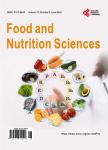Informing Food Consumption Choices: Innovations in Measuring and Labelling
Informing Food Consumption Choices: Innovations in Measuring and Labelling作者机构:School of Environment Science and Engineering Southern Cross University Lismore Australia School of Health and Human Sciences Southern Cross University Lismore Australia Lifestyle Medicine and Applied Health Promotion Southern Cross University Lismore Australia
出 版 物:《Food and Nutrition Sciences》 (食品与营养科学(英文))
年 卷 期:2016年第7卷第12期
页 面:1149-1170页
学科分类:07[理学] 0701[理学-数学] 070101[理学-基础数学]
主 题:Food Categories Food Labelling NuVal Nutrition Carbon Labelling
摘 要:The need to inform consumers about the health impact of their food choices is ever more pressing in a world where obesity is a growing problem. Concerns over food safety, its origins and its environmental impacts are also growing, as frequently reported in the popular press in many parts of the world. Nutritional and health information on food labels is quite well developed, but the complex nature of the information presented may hinder widespread use of the existing labels. In comparison, there has been little widespread success of carbon labels on food, and their usefulness in reducing carbon emissions from consumption is uncertain. In an attempt to address the need for clearer information on health and environmental impacts of food purchases, we present a novel dual-purpose food labelling system which provides information on both health and environmental impacts of food items. This paper presents results from a pilot study introducing a novel approach to food labelling: a simplified, combined carbon and health label to inform consumers simultaneously about the environmental and health impacts of their choices. Environmental impacts of various food categories were calculated on the basis of their relative energy use along the supply chain by using a newly designed Food Energy Index. Health impacts were based on the NuVal system developed in the USA in 2010. As part of the Norfolk Island Carbon and Health Evaluation study (NICHE), labels were designed, tested and displayed on 25 food categories for a 3-month period in the main supermarket on Norfolk Island (Australia). The in-store labelling trial was followed by a consumer survey on their attitudes to the labels. The results from this pilot trial indicate that consumers were supportive of food labelling including both environmental and health impacts, but the information provided in the dual labels was not sufficient to induce changes in consumption between food categories. We conclude that simple label design is



